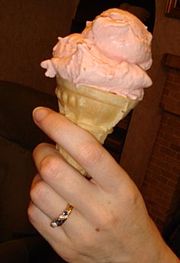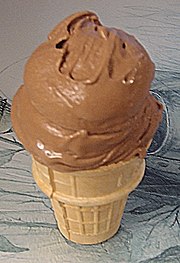Ice Cream Cone Patents
Now the question is: Who invented the first commercial ice cream cone? Up until recently, historians seem to think that Italo Marchiony's patent in 1903 was the inventor (see 1903 - Italo Marchiony below). Recently Steve Church of Ridgecrest, California discovered a long forgotten patent for an Apparatus for Baking Biscuit Cups for Ice Cream by Antonio Valvona of Manchester, England. This patent, by Antonoio Valvona, clearly shows that the ice cream cone had been around prior to Italo Marchiony's patent.
1902 - Antonio Valvona of Manchester, England received Patent No. 701,776 on June 3, 1902 for an "Apparatus for Baking Biscuit Cups for Ice Cream." The patent says:
"By the use of the apparatus of this invention I make cups or dishes of any preferred design from dough or paste in a fluid state this is preferably composed of the same materials as are employed in the manufacture of biscuits, and when baked the said cups or dishes may be filled with ice-cream, which can then be sold by the venders of ice-cream in public thoroughfares or other places."
Antonio Valvona (A.Valvona & Co. Ltd) was firstly an ice cream manufacturer and in 1901 was listed at Glasshouse Street, Ancoats Manchester. In 1907, he moved his biscuit operation to The Bridgewater Mill, Rodney Street, Ancoats. In 1919, the families Colaluca and Rocca opened a factory in Mill Street, Ancoats later trading as the Colroc Biscuit Co. Ltd. Colroc closed in the late 1950's, and Valvona having sold to new owners moved to Oldham north Manchester but closed in the late 1970's.
1903 - On September 20, 1903, Italo Marchiony (1868-1954), an Italian immigrant living in New York, NY, filed a patent application for a "molding apparatus for forming ice-cream cups and the like." U.S. Patent No. 746,971 was issued to him on December 15, 1903. His patent drawings show a mold for shaping small cups, complete with tiny handles - not a cone. His invention in his patent application is described as:
"This invention relates to molding apparatus, and particularly such molding apparatus as is used in the manufacture of ice-cream cups and the like."
Marchiony always insisted that he had been making cones since 1896 where he sold his homemade ice cream (lemon ice) from a pushcart (hokey-pokey) on Wall Street in New York. He originally used liquor glasses to serve his ice cream in. To reduce his overhead, caused by customers breaking or wandering off with his serving glasses, he baked edible waffle. While the waffles were still warm, he folded them into the shape of a cup (with sloping sides and a flat bottom). His waffle cups made him the most popular vendor on Wall Street and soon afterward, he had a chain of 45 carts operated by men he hired.
When cones became popular after the 1904 St. Louis Fair, Marchiony tried to protect his patent through legal channels but failed. Since Marchiony's patent was for only the specific mold construction and there were lots of other ways to mold cones, his patent was not much good. Marchiony's ice cream and wafer company thrived at in Hoboken, New Jersey until his plant was destroyed by fire in 1934. He retired from his business in 1938. It wasn't until Marchhiony's obituary was printed in the New York Times on October 29, 1954, that this story was made public.
1912 - According to some historians, cones were rolled by hand until 1912, when Frederick Bruckman, an inventor from Portland, Oregon, patented a machine for doing the rolling. In 1928, Nabisco bought out Bruckman's company and rights. Presently, I can find no patent record for this.
1924 - U.S. patent No.1,481,813 for an ice cream cone rolling machine was issued to its inventor, Carl R. Taylor of Cleveland, Ohio on January 29, 1924. He described it as a "machine for forming thin, freshly baked wafers while still hot into cone shaped containers" for ice-cream. Multiple dies were designed on a turntable, such that when formed, the cone had time to cool and harden before rotating into position for release. The whole machine was to be set up beside a batter baking machine which provides the supply of the hot, flat wafers.















